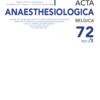Postoperative pain after cesarean section: an audit of practice after implementation of the PROSPECT recommendations
Postoperative pain, Cesarean section; PROSPECT; wound infiltration; audit; dexamethasone
Published online: Mar 29 2022
Abstract
Cesarean section (CS) is the most frequently performed surgical intervention worldwide. Post- cesarean pain is often underestimated and undertreated and can impair rapid maternal recovery, mother and child bonding and breastfeeding. Recently, PROSPECT recommendations on postoperative pain for CS were published and they include systematic paracetamol and non-steroidal anti-inflammatory drugs (NSAIDs), intravenous dexamethasone, neuraxial morphine/dia- morphine or an abdominal wall block or wound infiltration, abdominal wall binders, non-closure of the peritoneum and a Joel-Cohen incision. Opioids are administered as rescue. In UZ Leuven, these PROSPECT recommendations were implemented at the end of 2020. To evaluate the efficacy of these PROSPECT recommendations, a prospective audit was performed from January 1 st , 2021 till April 30 th , 2021. All patients with a CS were prospectively followed for correct implementation of the pain protocol and for pain scores in rest and at mobilization. Rescue opioid consumption as well as patient satisfaction were recorded. 185 consecutive patients that had undergone a CS were included in the audit. In 55 patients the pain protocol was not followed mostly due to no or reduced administration of NSAIDs. Patient satisfaction was high, especially in patients in which the protocol was followed. Pain scores at rest and at mobilization were low and the percentage of patients having pain scores above 30 mm VAS remained low. Rescue opioid consumption was low. We conclude that the implementation of the PROSPECT based pain protocol after CS was effective in controlling pain, reducing opioid consumption and resulted in high patient satisfaction especially if the protocol was correctly followed. Omission of NSAIDs is occurring relatively frequent, but mostly because of valid medical reasons to omit NSAIDs.
